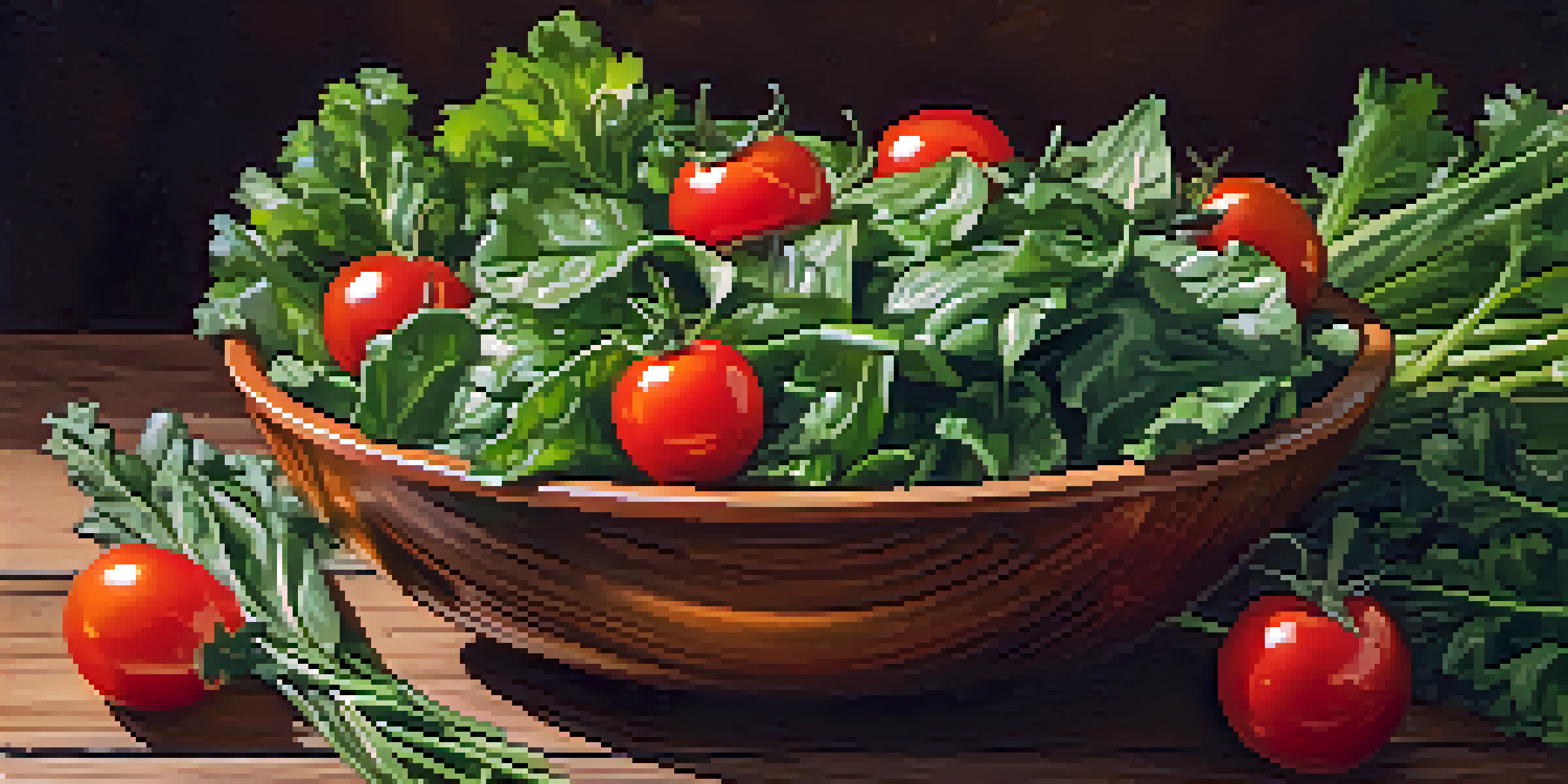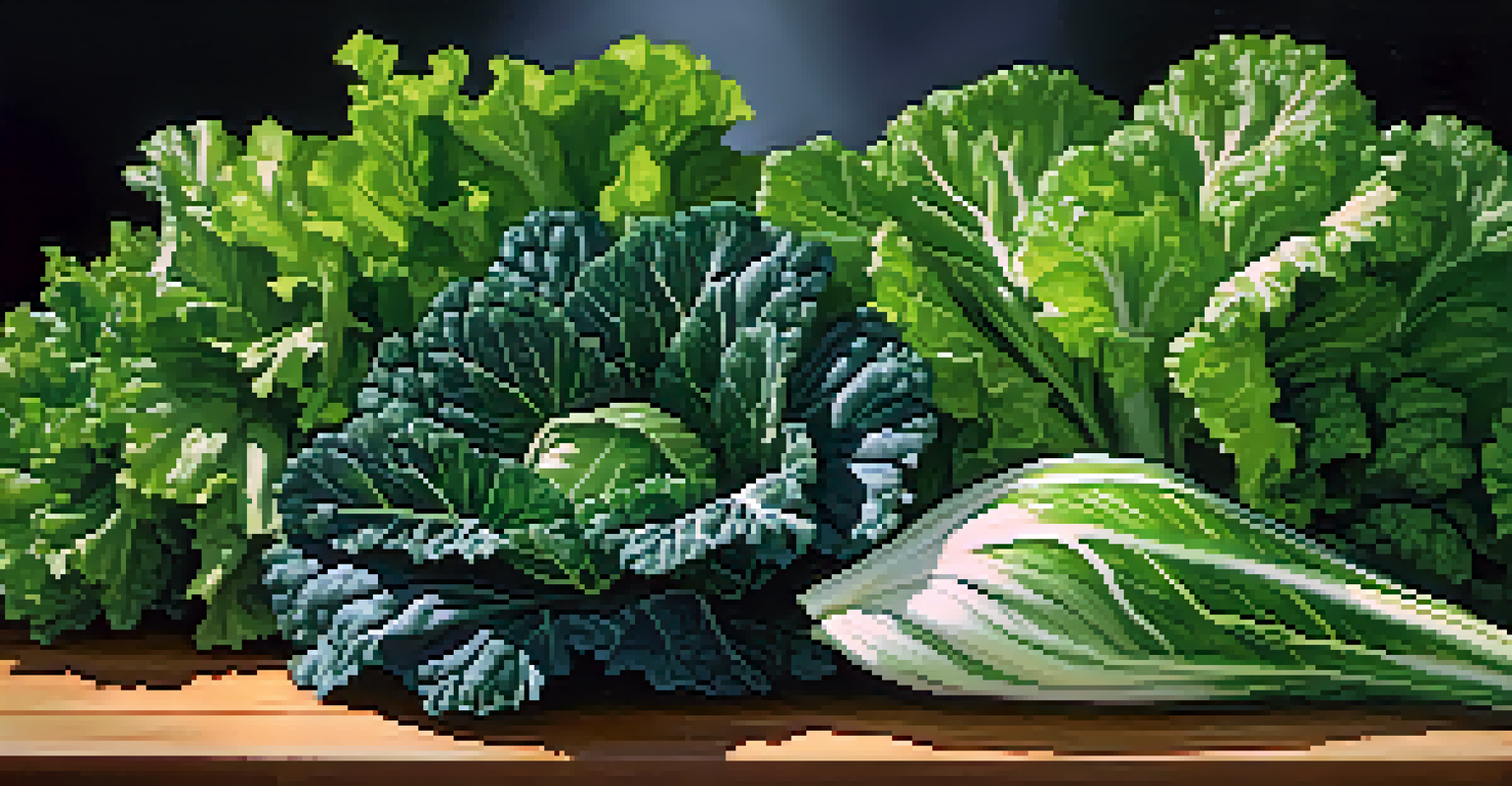Nutrient Density in Leafy Greens: A Raw Food Perspective

Understanding Nutrient Density and Leafy Greens
Nutrient density refers to the amount of essential nutrients found in a food relative to its calorie content. Leafy greens, such as spinach, kale, and Swiss chard, are prime examples of nutrient-dense foods. They pack a powerful punch, offering vitamins, minerals, and antioxidants without a lot of calories, making them ideal for those pursuing a raw food diet.
Let food be thy medicine and medicine be thy food.
For instance, a cup of raw spinach contains a wealth of vitamin K, vitamin A, and folate, all while being incredibly low in calories. This means you can eat a generous portion without worrying about calorie overload, allowing you to fill your plate with vibrant greens. The raw food perspective emphasizes these benefits, promoting the idea that eating foods in their natural state maximizes their nutritional value.
Incorporating leafy greens into your meals not only boosts your nutrient intake but also adds texture and flavor. Whether in salads, smoothies, or as wraps, these greens can easily be included in your daily meals, making it simple to embrace a nutrient-rich lifestyle.
The Role of Leafy Greens in a Raw Food Diet
In a raw food diet, which emphasizes uncooked and unprocessed foods, leafy greens play a vital role. They contribute essential vitamins and minerals that support overall health while maintaining the integrity of their nutrients. Eating these greens raw ensures that you benefit from their full nutritional profile, as cooking can often diminish nutrient levels.

Moreover, leafy greens are incredibly versatile and can be used in various dishes. From fresh salads to green smoothies or even raw pesto, these greens can elevate your meals while keeping them nutrient-dense. This versatility not only makes it easier to incorporate them into your diet but also keeps your meals exciting and delicious.
Leafy Greens Boost Nutrient Intake
Leafy greens like spinach and kale are nutrient-dense foods, providing essential vitamins and minerals without excess calories.
One of the key benefits of including leafy greens in a raw food context is their high water content, which helps with hydration. Drying out from processed foods can leave you feeling sluggish, but the natural moisture found in leafy greens revitalizes your body and keeps your energy levels up.
Key Nutrients Found in Leafy Greens
Leafy greens are rich in several key nutrients, making them a powerhouse for health. Vitamins A, C, and K are abundant in many varieties, each contributing to skin health, immune function, and bone strength. For example, vitamin K is crucial for blood clotting and bone health, while vitamin C supports your immune system and helps in the absorption of iron from plant-based sources.
Eating greens is a way to elevate your diet, giving your body the nutrients it needs to function at its best.
Minerals such as iron, calcium, and magnesium are also found in significant amounts in leafy greens. Spinach, for instance, is often highlighted for its iron content, which is vital for energy production and transporting oxygen in the blood. These nutrients work synergistically to support various bodily functions, emphasizing why leafy greens are essential in the raw food diet.
Moreover, antioxidants like lutein and zeaxanthin found in dark leafy greens play a significant role in eye health. They help protect against age-related macular degeneration, ensuring that your vision remains sharp as you age. By consuming a variety of leafy greens, you can enjoy a broad spectrum of nutrients beneficial for your overall health.
Popular Leafy Greens and Their Benefits
When it comes to leafy greens, there are numerous options to choose from, each offering unique health benefits. Kale, often dubbed a superfood, is rich in vitamins and has antioxidant properties that may help reduce the risk of chronic diseases. Its robust flavor works well in salads, smoothies, and even as baked chips.
Another popular choice is Swiss chard, known for its vibrant colors and high levels of vitamin K and fiber. This green can be added to salads or lightly sautéed to maintain its nutritional integrity while enhancing its taste. The wide range of textures and flavors among leafy greens means you can mix and match them to keep your diet interesting.
Versatile in Raw Food Diets
Incorporating leafy greens into meals enhances flavor and nutrition, making it easy to maintain a raw food lifestyle.
Spinach, with its mild taste, is incredibly versatile and can be used in smoothies, salads, and various dishes. It is packed with essential nutrients while being low in oxalates, making its iron and calcium more bioavailable. By exploring different leafy greens, you can discover a world of flavors while reaping their health benefits.
Incorporating Leafy Greens into Your Daily Meals
Integrating leafy greens into your daily meals doesn't have to be a chore. Start your day with a green smoothie by blending spinach or kale with fruits like bananas and berries for a delicious and nutritious breakfast. This easy swap not only enhances your nutrient intake but also keeps your energy levels stable throughout the morning.
For lunch, consider a hearty salad topped with a variety of leafy greens, some colorful veggies, and a protein source like chickpeas or nuts. The combination of textures and flavors will not only satisfy your taste buds but also provide essential nutrients to keep you fueled for the afternoon. Don't forget to experiment with dressings that complement the greens and elevate the dish.
Lastly, for dinner, try using leafy greens as wraps instead of traditional tortillas. Large leaves of romaine or collard greens can hold your favorite fillings, creating a fresh and satisfying meal. This creative approach allows you to enjoy the benefits of leafy greens while keeping your meals light and nutritious.
The Environmental Impact of Leafy Greens
Choosing leafy greens, especially when sourced locally, can have a positive impact on the environment. These vegetables often require less water and land compared to other crops, making them a more sustainable choice. By opting for local farms or community-supported agriculture (CSA) programs, you not only support your health but also contribute to environmental conservation.
Additionally, growing your leafy greens, even in small home gardens or window boxes, can significantly reduce your carbon footprint. It allows you to enjoy the freshest produce while minimizing transportation emissions associated with store-bought options. This connection to your food can enhance your appreciation for the nutrients they provide.
Positive Environmental Impact
Choosing locally sourced leafy greens supports sustainability and reduces your carbon footprint.
Emphasizing a diet rich in leafy greens aligns well with environmentally conscious living. As you prioritize nutrient density in your meals, you're also making choices that can lead to a healthier planet, proving that what you eat can indeed make a difference.
Conclusion: Embracing Nutrient-Dense Leafy Greens
In conclusion, leafy greens are a vital component of a raw food diet, offering an array of nutrients that support overall health. Their versatility makes them easy to incorporate into various meals, ensuring you can enjoy their benefits without sacrificing flavor. By understanding the importance of nutrient density, you can make informed choices that enhance your diet.
Moreover, the positive environmental impact of consuming and growing leafy greens adds another layer of benefit to your choices. The journey of embracing a nutrient-dense lifestyle is not just about personal health; it also reflects a commitment to sustainability and mindful eating.

So, whether you’re blending a smoothie or tossing a salad, remember that every bite of leafy greens is a step towards better health and a healthier planet. Enjoy the journey of discovering the vibrant world of leafy greens and the many ways they can enrich your life.